Buffalo Creek Reservation facts for kids
The Buffalo Creek Reservation was a large area of land in what is now Erie County, New York. It covered about 49,920 acres (202 km2). This land was set aside for the Seneca Nation. This happened after talks with the United States following the American Revolutionary War.
Contents
The Story of the Buffalo Creek Reservation
Early History of the Land
The land around Buffalo Creek was taken by the Seneca people in the 1600s. They gained it from a group called the Wenrohronon. The Seneca started living in this area between 1660 and 1690. This was a time when the Iroquois nations, including the Seneca, were expanding their lands. They were looking for more hunting grounds.
The American Revolution and Its Impact
During the American Revolution, the Seneca people were allies of the British. In 1779, the American army, led by the Sullivan Expedition, destroyed many Seneca towns. The Seneca people lost their homes and had to flee. They sought safety with the British at Fort Niagara. Reports say the British helped feed and house over 5,000 Native American refugees.
After a very harsh winter in 1779–80, the Iroquois people began to spread out. Joseph Brant led a group of different tribal members to the Grand River in Canada. There, the British Crown promised them a large area of land. The Tuscarora went to Lewiston. The remaining Seneca, Cayugas, and Onondaga peoples chose to settle at Buffalo Creek. Their leaders included Sayenqueraghta (also known as Old King) and his son-in-law, Roland Montour.
Losing Land: Treaties and Forced Moves
Because the Seneca had sided with the British, who lost the war, the United States made them give up most of their land. In 1797, through the Treaty of Big Tree, the Seneca gave up almost all of Western New York. They were allowed to keep twelve reservations, and Buffalo Creek was one of them. This reservation covered much of the area where the city of Buffalo, New York is today. By 1817, about 700 Seneca people lived on the reservation. There were also smaller numbers of other displaced people.
In 1838, the United States forced the Seneca to agree to the Treaty of Buffalo Creek. This was part of a policy called Indian Removal. This policy, started by President Andrew Jackson, aimed to move Native Americans from their lands. The treaty demanded that the Seneca of western New York give up all their reservation lands. They were told to move west of the Mississippi River, to places like Wisconsin and Indian Territory (which is now Oklahoma). They had five years to move.
However, the land sale that led to this treaty did not happen. So, the U.S. negotiated a new treaty, which was approved in 1842. In the 1840s, the Seneca began selling parts of the reservation to European Americans. Some land was sold to members of the Ebenezer Society.
The Buffalo Creek reservation was the only one of the Seneca's reservations to be completely dissolved. The Seneca were able to keep their Cattaraugus, Oil Springs, Allegany, and Tonawanda reservations. This happened after important legal battles in the 1850s. Leaders like Onondaga chief Samuel George helped fight for these lands.
The Reservation Today
Today, the Buffalo Creek Reservation is a nine-acre piece of land. This small plot was part of the original, much larger reservation. In 2010, the Seneca Nation bought this land from Carl Paladino. His company, Ellicott Development Company, still owns much of the land around it.
The Seneca Nation built the Seneca Buffalo Creek Casino on this property. The money earned from the casino is used to help the Seneca community grow and develop. In 2020, a branch of their "Seneca One Stop" convenience store chain was built on the plot. It was planned to open in 2021.


